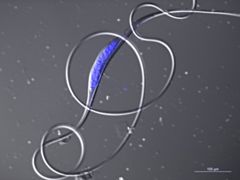Project 3123: R.A. Gomez, D.R. Maddison. 2020. Novelty and emergent patterns in sperm: Morphological
diversity and evolution of spermatozoa and sperm conjugation
in ground beetles (Coleoptera: Carabidae). Journal of Morphology. 281 (8):862-892.

Specimen: Clivina fossor (Linnaeus, 1758) (/RAGspcmn0000000542)
View: Merged image of DIC and DAPI-stained sperm
View: Merged image of DIC and DAPI-stained sperm
Abstract
The beetle family Carabidae, with about 40,000 species, exhibits enough diversity in sperm structure and behavior to be an excellent model system for studying patterns and processes of evolution. We explore their potential, documenting sperm form in 177 species of ground beetles using light microscopy and collecting data on one qualitative and seven quantitative phenotypic traits. Our sampling captures 61% of the tribal‐level diversity of ground beetles. These data highlight the notable morphological diversity of sperm in ground beetles and suggest that sperm in the group have dynamic evolutionary histories with much morphological innovation and convergence. Sperm vary among species in total length (48–3,400 μm), head length (0.5–270 μm), and head width (0.2–6.3 μm). Most ground beetles make sperm with heads that are indistinct from the flagella at the gross morphological level. However, some or all Omophron, Trachypachus, and Dyschiriini make broad‐headed sperm that show morphological differences between species. Most ground beetles package their sperm into groups of sperm, termed conjugates, and ground beetles show variation in conjugate form and in the number and arrangement of sperm in a conjugate. Most ground beetles make sperm conjugates by embedding their sperm in a hyaline rod or spermatostyle. The spermatostyle is remarkably variable among species and varies in length from 17 to 41,000 μm. Several unrelated groups of ground beetles make only singleton sperm, including Nebriinae, Cicindelinae, many Trechinae, and the tribe Paussini. In order to study patterns in sperm evolution, we combine these data with a low‐resolution phylogeny of ground beetles. Results from modern comparative analyses suggest the following: (a) sperm differ from conjugates in some aspect of their underlying evolutionary process, (b) sperm have influenced conjugate evolution and vice versa, and (c) conjugation with a spermatostyle likely evolved early within the history of Carabidae and it has been lost independently at least three times.Read the article »
Article DOI: 10.1002/jmor.21144
Project DOI: 10.7934/P3123, http://dx.doi.org/10.7934/P3123
| This project contains |
|---|
Download Project SDD File |
Currently Viewing:
MorphoBank Project 3123
MorphoBank Project 3123
- Creation Date:
27 February 2018 - Publication Date:
03 September 2020 - Media downloads: 5

This research
supported by
Authors' Institutions ![]()
- Oregon State University
Members
| member name | taxa |
specimens |
media |
| R. Antonio Gomez Project Administrator | 177 | 397 | 6676 |
Project has no matrices defined.
Project downloads 
| type | number of downloads | Individual items downloaded (where applicable) |
| Total downloads from project | 117 | |
| Project downloads | 112 | |
| Media downloads | 5 | M585640 (1 download); M585643 (1 download); M585588 (1 download); M585659 (1 download); M585631 (1 download); |
